Medical chronologies are detailed and organized timelines that systematically document an individual’s medical history, treatments, and related events. Within the context of workers’ compensation, these chronologies play a central role in presenting a comprehensive overview of an injured worker’s healthcare journey. They provide a clear and chronological record of diagnoses, treatments, surgeries, and rehabilitation efforts, offering a valuable resource for legal professionals, insurance entities, and medical experts involved in the adjudication of workers’ compensation claims. This blog explores the role medical chronologies play in workers’ compensation cases and everything related to it. Stick to the end to know in-depth details on this.
Understanding Medical chronology
A medical chronology is a comprehensive document that systematically organizes medical information, treatment details, and timelines related to an individual’s injury or illness. In the realm of legal proceedings, particularly within the context of workers’ compensation cases, medical chronologies play a crucial role in presenting a concise and structured overview of an injured worker’s health journey.
The primary purpose of a medical chronology is to provide attorneys, judges, insurance professionals, and other stakeholders with a chronological and detailed account of the medical aspects associated with a worker’s injury or illness. It includes a thorough examination of medical records, diagnostic procedures, treatments administered, and relevant events in a time-sequenced format.
Key Elements of a Comprehensive Medical Chronology
A comprehensive medical chronology serves as a foundational document in the assessment and understanding of an individual’s medical history, particularly in the context of workers’ compensation cases. The following key elements are essential to its construction:
Medical Records:
- Inclusion of detailed medical records, encompassing consultations, examinations, and medical interventions.
- The chronological arrangement of records provides a seamless narrative of the patient’s healthcare journey.
Diagnostic Tests:
- Integration of all relevant diagnostic tests, including imaging, laboratory results, and specialized examinations.
- Precision in documenting dates and outcomes to establish a clear timeline of diagnostic assessments.
Treatments and Interventions:
- Thorough documentation of treatments administered, medications prescribed, and therapeutic interventions undertaken.
- Emphasis on the effectiveness and impact of each treatment on the patient’s health condition.
Surgeries:
- Detailed accounts of any surgical procedures, including pre-operative assessments, the surgical process, and post-operative care.
- Highlighting the surgical timeline and its connection to the overall medical narrative.
Physician Notes:
- Inclusion of comprehensive physician notes, capturing observations, evaluations, and prognoses.
- Ensuring that physician notes provide insights into the patient’s response to treatments and the evolution of their condition.
Reports:
- Incorporation of any pertinent medical reports, such as specialist consultations, imaging reports, and expert opinions.
- Clear presentation of findings and recommendations from various medical professionals involved in the patient’s care.
Significance of Accuracy, Completeness, and Clarity
The accuracy, completeness, and clarity of these key elements are fundamental to the integrity of a medical chronology:
- Accuracy in Documentation: Precision in recording dates, medical procedures, and health assessments is critical for establishing a reliable medical timeline.
- Completeness of Information: Thoroughness in including all relevant details ensures a holistic understanding of the patient’s medical journey, leaving no gaps in information.
- Importance of Clear Presentation: Clarity in the organization and presentation of medical data enhances the comprehensibility of the chronology, facilitating easier interpretation by various stakeholders.
In the realm of workers’ compensation, where legal decisions hinge on the medical narrative, a comprehensive and accurately detailed medical chronology becomes an indispensable tool. The precision of these key elements empowers legal professionals, insurers, and healthcare providers to make informed decisions, assess the causal relationship between work-related activities and health conditions, and ensure fair outcomes for all parties involved.
Benefits and Impact of Incorporating Medical Chronology in Workers’ Compensation Cases
Structured Efficiency
Medical chronologies play a pivotal role in expediting the review process within workers’ compensation cases. Their organized and structured format presents a comprehensive timeline of medical events, treatments, and interventions, allowing legal professionals to efficiently navigate complex medical narratives. This structured efficiency not only saves time but also streamlines the assessment of crucial medical information.
Time Savings for Legal Professionals
The advantages of incorporating medical chronology extend to time savings for legal professionals involved in workers’ compensation cases. The meticulous compilation of medical records, diagnostic tests, treatments, and surgeries into a chronological order eliminates the need for extensive manual review. Legal practitioners can quickly grasp the essential details, enhancing their ability to make informed decisions within the constraints of often tight timelines.
Clarity for Stakeholders
The clarity provided by medical chronologies ensures that all stakeholders involved in a workers’ compensation case are on the same page. From legal professionals and insurers to healthcare providers and, ultimately, the affected parties, a well-constructed chronology fosters a shared understanding of the medical narrative. This clarity is instrumental in preventing misunderstandings, disputes, and misinterpretations, contributing to a more efficient and fair resolution of cases.
Enhanced Claim Strength
Medical chronology significantly bolsters the strength of a workers’ compensation claim. By presenting a comprehensive and coherent medical narrative, these chronologies provide a clear link between work-related activities and resulting health conditions. This evidentiary support enhances the credibility of the claim, offering a solid foundation for legal arguments and negotiations. In turn, a strengthened claim increases the likelihood of a favorable outcome for the injured worker seeking compensation.
Facilitating Informed Decision-Making
The impact of medical chronologies goes beyond mere efficiency; it facilitates informed decision-making. Legal professionals can assess the causal relationship between workplace activities and health conditions with greater clarity and accuracy. This informed decision-making is crucial not only for the resolution of individual cases but also for establishing precedents and guidelines in workers’ compensation jurisprudence.

Crafting a Comprehensive Medical Chronology
Collaboration between Legal and Medical Professionals
- Joint effort leveraging legal and medical expertise.
- Legal professionals provide the framework for workers’ compensation cases.
- Medical professionals contribute insights into medical records, diagnoses, and treatments.
Meticulous Review of Medical Records
- Thorough examination of extensive medical records.
- Inclusion of consultations, diagnostic tests, treatments, surgeries, and physician notes.
- Capturing nuanced details to accurately represent the individual’s health history.
Interpreting Complex Information
- Collaborative interpretation of intricate medical details.
- Ensuring accurate understanding and representation of the medical narrative.
- Identification of key events and establishing causation in workers’ compensation cases.
Distillation into a Chronological Format
- Structured arrangement of medical events in chronological order.
- Highlighting the progression of the individual’s health condition.
- Creating a cohesive and understandable narrative for stakeholders.
Technological Advancements and Specialized Software
- Utilization of technology, including specialized software.
- Efficient organization, categorization, and retrieval of medical information.
- Streamlining the chronology-building process, enhancing accuracy, and reducing errors.
Accurate and Efficient Chronologies
- Incorporation of advanced software for real-time collaboration.
- Simultaneous edits, change tracking, and seamless communication.
- Time-saving and precise creation of accurate and efficient medical chronologies.
In summary, crafting a comprehensive medical chronology involves the collaborative efforts of legal and medical professionals, a meticulous review of medical records, interpretation of complex information, distillation into a chronological format, and the integration of technological advancements for accuracy and efficiency.
Key Challenges and Considerations
Handling Voluminous Medical Records
- Sorting through extensive medical documentation to extract relevant information.
- Dealing with large quantities of data, including consultations, test results, treatments, and surgeries.
Maintaining Accuracy
- Navigating complex medical terminology and details to ensure precision.
- Avoiding errors or omissions that could impact the integrity of the medical chronology.
Compliance with HIPAA
- Adhering to the Health Insurance Portability and Accountability Act (HIPAA) regulations.
- Safeguarding patient privacy and ensuring the secure handling of sensitive health information.
Safeguarding Patient Confidentiality
- Implementing robust protocols to protect patient confidentiality during the creation and utilization of medical chronologies.
- Balancing the need for information with ethical considerations surrounding privacy.
Time Constraints
- Managing time constraints associated with the review, interpretation, and creation of comprehensive medical chronologies.
- Balancing the need for thoroughness with the demand for timely resolution in workers’ compensation cases.
Conclusion
In the intricate tapestry of workers’ compensation cases, medical chronologies emerge as a beacon of clarity. Their role in providing a structured, chronological account of an individual’s medical journey is indispensable. As we navigate the ever-evolving landscape of legal proceedings, the significance of medical chronologies will continue to grow, ensuring a fair, efficient, and informed resolution for workers and all stakeholders involved in the pursuit of justice.
Similar blogs:
Medical Chronology for Social Security Disability Cases: Ensuring Thoroughness
Medical Chronology and Expert Testimony: Strengthening Case Presentation
Don’t Miss Out! How Radiology and Medical Imaging Transforms Medical Chronology!







































